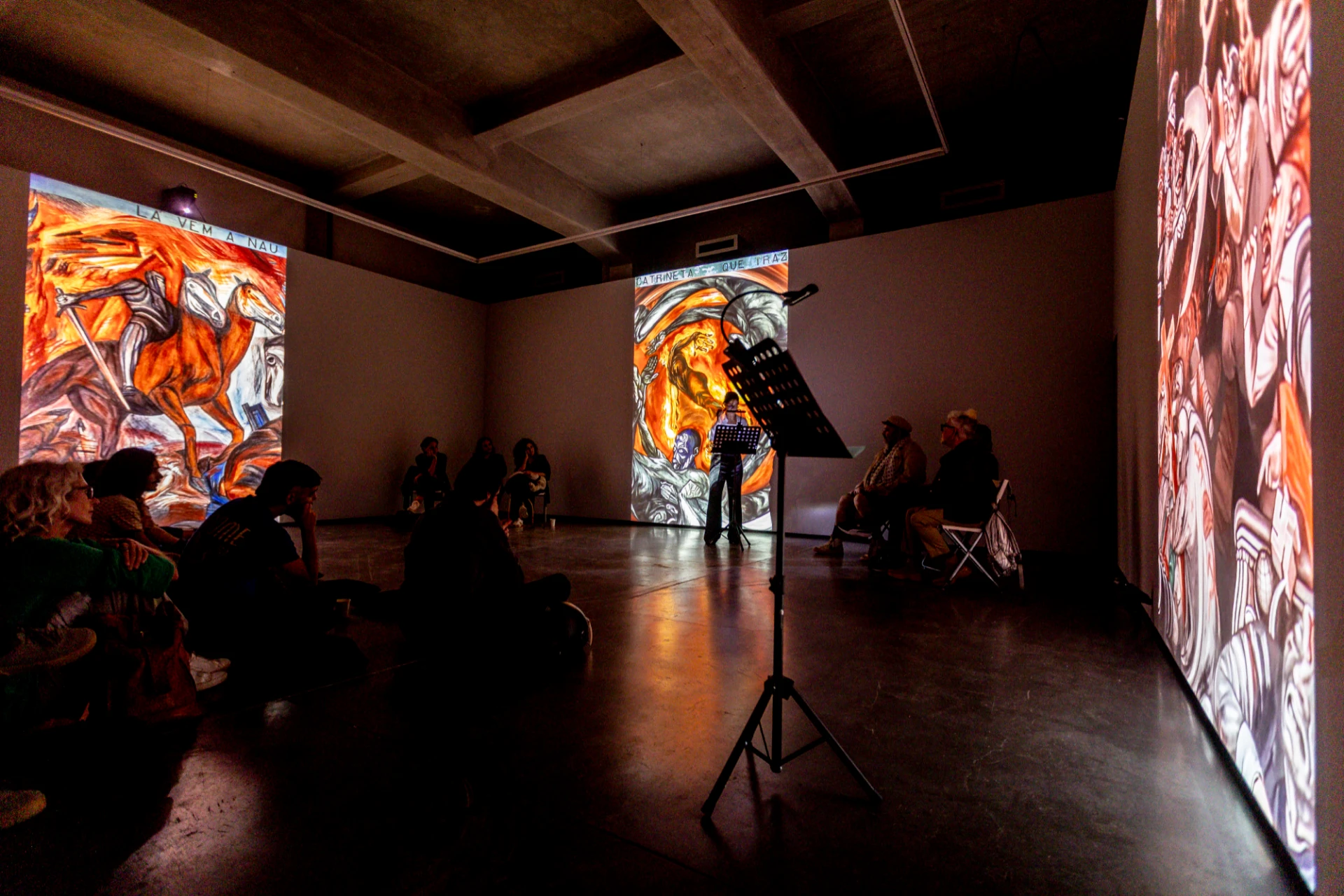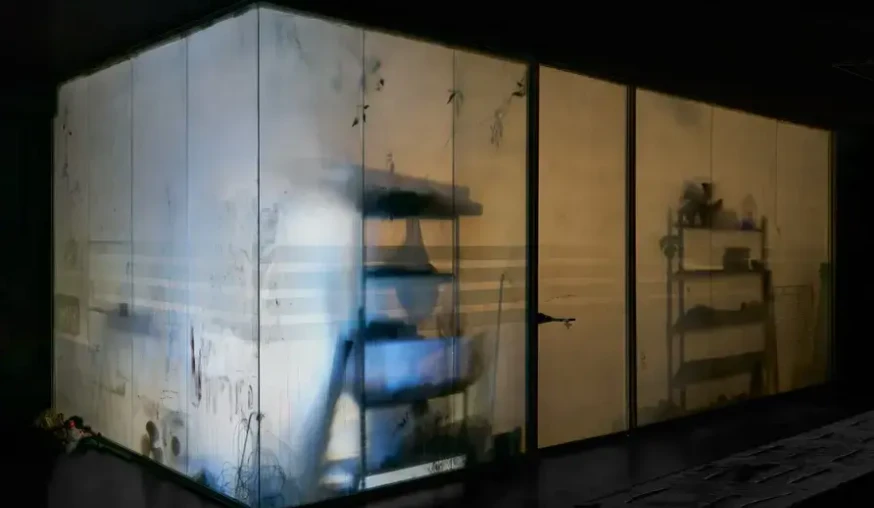article
To stage is to love: to love and devour, by Tolia Astakhishvili
Throughout my life, I've had the happy pleasure of sharing a house with my grandmother. Like in most grandparents' houses, things and little trinkets, constantly being discovered little by little, dominate the place, building and ultimately becoming the space they inhabit. Over the years, these memory devices, living on the magical vitamin of anachronism, have formed my structure, appearing and disappearing, until I myself became the place I inhabit. This is how I felt in love and devour by the Georgian artist Tolia Ashakhishvili and curated by Hans Ulrich Obrist, in the newly opened but still-to-be-renovated space of the Nicoletta Fioruci Foundation in Venice, an exhibition that evokes memory while reminding us of the importance of forgetting.
Nothing indicates the exhibition in the Dorsoduro neighborhood other than a strip of painter's tape with the title handwritten on it, stuck to the top of the building's doorbell, escaping even the most attentive eye—what palazzo? After discovering the entrance, footsteps are announced by the crackling of accumulated debris, dust, and powder, as in a space in permanent arrangement, subject to the vicissitudes of time, or in a non-place in transit of identities1. Perhaps all three simultaneously, layer by layer. The artist's intentions must be parallel to the nature of the building, and identity and authorship play a fundamental role in the development of Tolia Ashakhishvili's work, who collaborates with various artists, including family, friends, and strangers, to create relationships with a creation that escapes her control and to foster new stories or gradually forget.
These architectural typologies provide the substance for her work, in a way that closely resembles conventional sculptural processes of addition and subtraction, employing them identically under drawings, photography, found objects, video, or sound to create her own places. Several times, Tolia Ashakhishvili creates spaces embedded within others, limbos between times in a semi-artificial realm, but not here. Having lived in this location for the first few months of this year, she fully embraced the place, and the artist's work acquired a meticulously natural force—like the only type of light that served as illumination—that allowed her work the elemental structure of a strange spatial familiarity that rarely occurs. The exhibition is where it is. One of the special things about this exhibition is precisely that: the intention was to completely remove something that is normally a platform of intimacy and a limiting factor in enjoyment, to place there such horizontality, whether in the direction of the space or in the direction of the visitor and their senses, that a spontaneous, detached, and above all, instinctive environment is formed. I saw myself as the individual in Herbert Bayer's Extended Vision Diagram, always at the center of everything, wherever I was. Each site I looked at allowed me to see everything at once or, recalling the text from the programme (with Obrist's reference to Deleuze), placed me in the middle of things, but at the centre of nothing.
The moment of inability to distinguish between what already lay there and what Tolia Ashakhishvili placed there is the guarantee that we feel at home, a breaking of the fourth wall of exhibitions. It seemed to me that, after all, we are the exhibition. We, the visitor, are there, discovering the details that are constantly under our noses, the things and little things that, in the end, matter. At the same time, as if in contradiction to the scenic decay of the building, it is impossible not to think about the protest against forgetting, of which Obrist is the first defender. Apparently, familiar photographs, eyeglasses, decorative elements, and intimate confessions written on the walls in the most remote places are, despite everything, known for being forgotten…? That is why, in understanding this exhibition as a real place within the city and not as a set of objects that form any situation that closes in on itself, I prefer to maintain the allusion that this sharing has been. I cannot, however, fail to mention three brief moments that are the exception to the rule.
The first piece, on the ground floor, is a film by the artist in collaboration with James Richards, I Remember (Depth of Flattened Cruelty), from 2023. For some reason I still can't quite explain, the unsettling collages of public, liminal, and empty spaces, reminiscent of M. C. Escher but with traces of warmth, impressed me. In the middle, we hear a passage from I Remember by Molly Drake, which defines the intention of the entire composition. Here, I invite you to listen to this song, which has stuck with me as the melody that resonates in the background of my memory.
Then, on the first floor, in a supposedly old bathroom with the water system exposed by the demolition of the walls at the artist's request, the key moment was actually an open window, which looked out onto a small balcony. I don't know if it was intentionally like that, but the natural murmur that could be heard coming from outside was brought into the room, invading it and reverberating there. See the epitome! A new dignity was created, a bridge, that will cross more than just canals… The last moment, along with this one, is the installation I love seeing myself through the eyes of others, 2025. In collaboration with Dylan Peirce, they built a large translucent box with silhouettes of elements, like in a shadow theater, complemented by sounds captured in cafes and other public spaces, a murmur mixed with the clinking of cutlery. The artist decided not to allow access to the interior, to give free rein to the imagination and preserve our capacity for imagination, to have a small fragment of something that gives us a ticket to another place.2 The bridge that leads the exhibition outside.
Tolia Ashakhishvili's work extends beyond you; it comes to our side.
Not forgetting, Hans Ulrich Obrist sees himself as an exhibition-maker (the famous Ausstellungsmacher of Harald Szeemann). Looking at the exhibition from a curatorial point of view, the question arises as to what to do when dealing with a body of work of processes that fit so well into the space for which it is proposed. In short, his mission is that of an accomplice. For Szeemann, this is the fundamental role of curatorial practice: to be an accomplice of the artists, long before anything else. To be, in fact, a substantially agile, moving and active intermediary in the triad artist – object – public, because, returning to Szeemann: to stage is to love3.
Finally, I conclude these lines with Rémy Zaugg:
The place of the work and of the human being is not on the Acropolis. Nor is it in the idyllic city park. It is in the everyday life of the human being. It is in the neighborhood where he buys his bread and his meat, for going to the place of the work and of the human being is an act as common and essential as going to catch a bus4.
The exhibition to love and devour by Tolia Ashakhishvili will be on display until November 23, 2025, at the Nicoletta Fioruci Foundation in Venice.
1. The two-story building, dating back to the 15th century—which will become the new space for the Nicoletta Fiorucci Foundation after renovations—has undergone several changes. It was an orphanage, served as a studio-residence for the Italian artist Ettore Tito in the 1920s, and also as the architectural studio of Angelo Scattolin in the 1930s.
2. Tolia Ashakhishvili and Olesia Shuvarikova, to love and devour: A Conversation with Tolia Ashakhishvili, September 2, 2025: https://flash---art.com/2025/09/to-love-and-devour-tolia-astakhishvili-in-conversation-with-olesia-shuvarikova%EF%BF%BC/
3. Harald Szeemann, To Stage is to Love in Harald Szeemann: Selected Writings (Getty Research Institute, 2018), pp. 346
4. Rémy Zaugg, The Art Museum of My Dreams or A Place for Work and Being Human, (Sternberg Press, 2013), pp. 59.
BIOGRAPHY
Tomás Saraiva (b. 2002) has a degree in Art and Heritage Sciences from the Faculty of Fine Arts in Lisbon and is studying for a master's degree in Curatorial Studies at the College of Arts of the University of Coimbra. Between painting and curating, he combines the artistic thinking he has been developing with his curatorial values, either solo or as a group. She has held and participated in several exhibitions at national and international level.
ADVERTISING
Previous
article

11 Nov 2025
Inhabiting an impossibility: Estaleiro Almada/Orozco by José André and Patrícia Portela
By António Figueiredo Marques
Related Posts

 [C] CGD, [L] MUSA_cred_Antonio_Jorge_Silva-256bq.jpg)